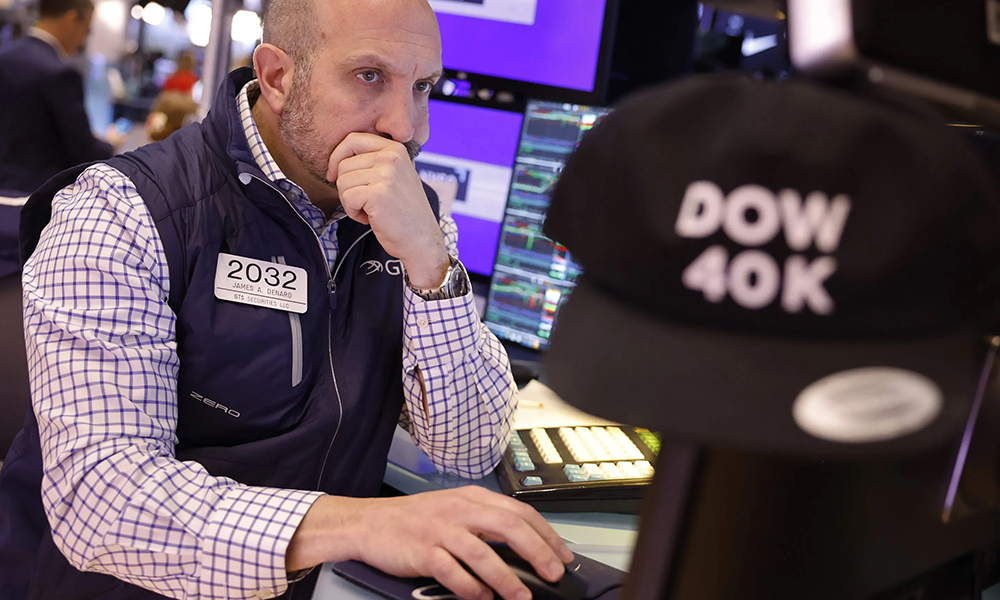
在經(jīng)過(guò)表現(xiàn)出色的2023年之后,今年美國(guó)股市依舊沒(méi)有受到惡性通脹和高利率的影響。從年初至今,標(biāo)普500指數(shù)上漲超過(guò)12%,創(chuàng)下歷史新高,在不到六個(gè)月的時(shí)間里,就超過(guò)了該藍(lán)籌股指數(shù)自1957年以來(lái)約10%的平均年度漲幅。強(qiáng)勁的第一季度財(cái)報(bào)季和有韌性的美國(guó)經(jīng)濟(jì),為股市的成功創(chuàng)造了條件,但華爾街的一些頂級(jí)策略師仍擔(dān)心經(jīng)濟(jì)下滑即將來(lái)臨。
Stifel首席股票策略師巴里·班尼斯特在周二的一份報(bào)告中表示,他預(yù)計(jì)到今年夏末,標(biāo)普500指數(shù)將下挫約10%,跌至4,750點(diǎn)。這位華爾街資深策略師曾在2023年認(rèn)為,如果按通脹率調(diào)整,股市回報(bào)可能在十年內(nèi)持平。他解釋了自己持悲觀立場(chǎng)的三個(gè)主要原因。
首先是“頑固的”通脹,這或許并不意外。班尼斯特?cái)?shù)月來(lái)一直警告稱(chēng),他認(rèn)為在2023年第二季度結(jié)束的長(zhǎng)達(dá)五個(gè)季度的“偽衰退”期間,美聯(lián)儲(chǔ)已經(jīng)“收獲”了所有通貨緊縮,而通貨緊縮通常伴隨著經(jīng)濟(jì)衰退。今年5月,他甚至認(rèn)為,這意味著美聯(lián)儲(chǔ)官員將通脹率恢復(fù)到2%的目標(biāo)只是“白日夢(mèng)”。
班尼斯特?fù)?dān)心,服務(wù)業(yè)支出強(qiáng)勁,加上醫(yī)療保健、金融和保險(xiǎn)成本上漲,將導(dǎo)致這一關(guān)鍵經(jīng)濟(jì)部門(mén)持續(xù)通脹。他表示,如果再加上超出先前預(yù)期的房?jī)r(jià)上漲、生產(chǎn)率增速放緩以及工資持續(xù)增長(zhǎng),那么就會(huì)出現(xiàn)“適度的滯脹”。
這位策略師警告稱(chēng),這種低增長(zhǎng)、適度通脹的前景可能會(huì)將標(biāo)普500指數(shù)的市盈率(用于評(píng)估該指數(shù)價(jià)值的指標(biāo))降低500點(diǎn),因?yàn)橥顿Y者會(huì)將較低的潛在收入增長(zhǎng)和較高的成本考慮在內(nèi)。
據(jù)《華爾街日?qǐng)?bào)》報(bào)道,今年股市大漲后,標(biāo)普500指數(shù)的市盈率略高于23倍。這遠(yuǎn)高于19.4倍的歷史平均市盈率。
在最近的股市上漲之后,并非只有班尼斯特在敲響警鐘。富國(guó)銀行(Wells Fargo)的策略大師斯科特·沃倫在周三的報(bào)告中告訴投資者“準(zhǔn)備迎接更大的股市波動(dòng)”。這位資深全球市場(chǎng)策略師寫(xiě)道:“未來(lái)幾個(gè)月,許多潛在問(wèn)題可能會(huì)引發(fā)金融市場(chǎng)波動(dòng)。”
與班尼斯特一樣,沃倫也將美聯(lián)儲(chǔ)的降息時(shí)機(jī)視為市場(chǎng)回調(diào)的潛在觸發(fā)因素。沃倫認(rèn)為,美聯(lián)儲(chǔ)的經(jīng)濟(jì)學(xué)家們?cè)?月份預(yù)測(cè)今年將有三次降息,而在6月份的聯(lián)邦開(kāi)放市場(chǎng)委員會(huì)(FOMC)會(huì)議上,他們很可能只預(yù)測(cè)一到兩次降息。這可能會(huì)給股市帶來(lái)問(wèn)題,因?yàn)樵S多投資者仍然預(yù)計(jì)今年會(huì)有多次(通常是)刺激市場(chǎng)的降息。
沃倫寫(xiě)道:“‘五月賣(mài)股別回頭’這句古老的市場(chǎng)箴言今年會(huì)奏效嗎?這還有待觀察,但我們預(yù)計(jì)[標(biāo)普500指數(shù)]在年底前不會(huì)有太大幅度的上漲。”
這位富國(guó)銀行策略師還警告稱(chēng),食品和能源價(jià)格高企將繼續(xù)打壓消費(fèi)者情緒,美國(guó)大選也可能帶來(lái)市場(chǎng)波動(dòng)。他建議投資者關(guān)注工業(yè)、材料、能源和醫(yī)療保健等行業(yè)內(nèi)規(guī)模較大的所謂“優(yōu)質(zhì)”公司,即資產(chǎn)負(fù)債表強(qiáng)勁、負(fù)債率低、盈利能力穩(wěn)健的公司,這些公司不屬于估值較高的科技領(lǐng)域。
同樣,Stifel的班尼斯特建議持有所謂“防御性?xún)r(jià)值股行業(yè)”的“優(yōu)質(zhì)”股票,這些行業(yè)通常比較穩(wěn)定,包括醫(yī)療保健、必需消費(fèi)品和公用事業(yè)行業(yè)等。
雖然這兩位策略師都認(rèn)為市場(chǎng)未來(lái)可能會(huì)經(jīng)歷陣痛,但也不全是壞消息。富國(guó)銀行的沃倫在總結(jié)時(shí)使用的幾句至理名言,值得每一位投資者時(shí)刻牢記:“如果我們有眼光,股市下行會(huì)帶來(lái)投資機(jī)會(huì)。做好準(zhǔn)備。制定計(jì)劃。保持謹(jǐn)慎。”(財(cái)富中文網(wǎng))
翻譯:劉進(jìn)龍
審校:汪皓
在經(jīng)過(guò)表現(xiàn)出色的2023年之后,今年美國(guó)股市依舊沒(méi)有受到惡性通脹和高利率的影響。從年初至今,標(biāo)普500指數(shù)上漲超過(guò)12%,創(chuàng)下歷史新高,在不到六個(gè)月的時(shí)間里,就超過(guò)了該藍(lán)籌股指數(shù)自1957年以來(lái)約10%的平均年度漲幅。強(qiáng)勁的第一季度財(cái)報(bào)季和有韌性的美國(guó)經(jīng)濟(jì),為股市的成功創(chuàng)造了條件,但華爾街的一些頂級(jí)策略師仍擔(dān)心經(jīng)濟(jì)下滑即將來(lái)臨。
Stifel首席股票策略師巴里·班尼斯特在周二的一份報(bào)告中表示,他預(yù)計(jì)到今年夏末,標(biāo)普500指數(shù)將下挫約10%,跌至4,750點(diǎn)。這位華爾街資深策略師曾在2023年認(rèn)為,如果按通脹率調(diào)整,股市回報(bào)可能在十年內(nèi)持平。他解釋了自己持悲觀立場(chǎng)的三個(gè)主要原因。
首先是“頑固的”通脹,這或許并不意外。班尼斯特?cái)?shù)月來(lái)一直警告稱(chēng),他認(rèn)為在2023年第二季度結(jié)束的長(zhǎng)達(dá)五個(gè)季度的“偽衰退”期間,美聯(lián)儲(chǔ)已經(jīng)“收獲”了所有通貨緊縮,而通貨緊縮通常伴隨著經(jīng)濟(jì)衰退。今年5月,他甚至認(rèn)為,這意味著美聯(lián)儲(chǔ)官員將通脹率恢復(fù)到2%的目標(biāo)只是“白日夢(mèng)”。
班尼斯特?fù)?dān)心,服務(wù)業(yè)支出強(qiáng)勁,加上醫(yī)療保健、金融和保險(xiǎn)成本上漲,將導(dǎo)致這一關(guān)鍵經(jīng)濟(jì)部門(mén)持續(xù)通脹。他表示,如果再加上超出先前預(yù)期的房?jī)r(jià)上漲、生產(chǎn)率增速放緩以及工資持續(xù)增長(zhǎng),那么就會(huì)出現(xiàn)“適度的滯脹”。
這位策略師警告稱(chēng),這種低增長(zhǎng)、適度通脹的前景可能會(huì)將標(biāo)普500指數(shù)的市盈率(用于評(píng)估該指數(shù)價(jià)值的指標(biāo))降低500點(diǎn),因?yàn)橥顿Y者會(huì)將較低的潛在收入增長(zhǎng)和較高的成本考慮在內(nèi)。
據(jù)《華爾街日?qǐng)?bào)》報(bào)道,今年股市大漲后,標(biāo)普500指數(shù)的市盈率略高于23倍。這遠(yuǎn)高于19.4倍的歷史平均市盈率。
在最近的股市上漲之后,并非只有班尼斯特在敲響警鐘。富國(guó)銀行(Wells Fargo)的策略大師斯科特·沃倫在周三的報(bào)告中告訴投資者“準(zhǔn)備迎接更大的股市波動(dòng)”。這位資深全球市場(chǎng)策略師寫(xiě)道:“未來(lái)幾個(gè)月,許多潛在問(wèn)題可能會(huì)引發(fā)金融市場(chǎng)波動(dòng)。”
與班尼斯特一樣,沃倫也將美聯(lián)儲(chǔ)的降息時(shí)機(jī)視為市場(chǎng)回調(diào)的潛在觸發(fā)因素。沃倫認(rèn)為,美聯(lián)儲(chǔ)的經(jīng)濟(jì)學(xué)家們?cè)?月份預(yù)測(cè)今年將有三次降息,而在6月份的聯(lián)邦開(kāi)放市場(chǎng)委員會(huì)(FOMC)會(huì)議上,他們很可能只預(yù)測(cè)一到兩次降息。這可能會(huì)給股市帶來(lái)問(wèn)題,因?yàn)樵S多投資者仍然預(yù)計(jì)今年會(huì)有多次(通常是)刺激市場(chǎng)的降息。
沃倫寫(xiě)道:“‘五月賣(mài)股別回頭’這句古老的市場(chǎng)箴言今年會(huì)奏效嗎?這還有待觀察,但我們預(yù)計(jì)[標(biāo)普500指數(shù)]在年底前不會(huì)有太大幅度的上漲。”
這位富國(guó)銀行策略師還警告稱(chēng),食品和能源價(jià)格高企將繼續(xù)打壓消費(fèi)者情緒,美國(guó)大選也可能帶來(lái)市場(chǎng)波動(dòng)。他建議投資者關(guān)注工業(yè)、材料、能源和醫(yī)療保健等行業(yè)內(nèi)規(guī)模較大的所謂“優(yōu)質(zhì)”公司,即資產(chǎn)負(fù)債表強(qiáng)勁、負(fù)債率低、盈利能力穩(wěn)健的公司,這些公司不屬于估值較高的科技領(lǐng)域。
同樣,Stifel的班尼斯特建議持有所謂“防御性?xún)r(jià)值股行業(yè)”的“優(yōu)質(zhì)”股票,這些行業(yè)通常比較穩(wěn)定,包括醫(yī)療保健、必需消費(fèi)品和公用事業(yè)行業(yè)等。
雖然這兩位策略師都認(rèn)為市場(chǎng)未來(lái)可能會(huì)經(jīng)歷陣痛,但也不全是壞消息。富國(guó)銀行的沃倫在總結(jié)時(shí)使用的幾句至理名言,值得每一位投資者時(shí)刻牢記:“如果我們有眼光,股市下行會(huì)帶來(lái)投資機(jī)會(huì)。做好準(zhǔn)備。制定計(jì)劃。保持謹(jǐn)慎。”(財(cái)富中文網(wǎng))
翻譯:劉進(jìn)龍
審校:汪皓
After a stellar 2023, the stock market has continued to brush off the impact of stubborn inflation and higher interest rates this year. The S&P 500 is up more than 12% year to date to a record high, topping the roughly 10% average annual rise in the blue-chip index since 1957 in under six months. A strong first-quarter earnings season and a resilient economy have underpinned stocks’ success, but some of Wall Street’s top strategists still fear a downturn is on the way.
In a Tuesday note, Stifel’s chief equity strategist Barry Bannister said he expects the S&P 500 to sink roughly 10% to 4,750 by the end of the summer. The Wall Street veteran—who argued in 2023 that the stock market returns could be flat for a decade, when adjusted for inflation—cited three main reasons for his bearish outlook.
The first, perhaps unsurprisingly, was “sticky” inflation. Bannister has warned for months now that he believes the Federal Reserve already “harvested” all the disinflation that typically comes with a recession during a five-quarter-long “pseudo-recession” that ended in the second quarter of 2023. In May, he even argued that this means Fed officials’ goal to return inflation to 2% is nothing but a “pipe dream.”
Bannister fears strong services spending along with rising health care, financial, and insurance costs will lead to persistent inflation in that key sector of the economy. Tack on more housing inflation than previously forecast, a slowing productivity growth rate, and persistent wage growth and you have a recipe for a “moderate form of stagflation,” he says.
This low-growth, moderate-inflation outlook could cut the S&P 500’s price-to-earnings ratio—a metric used to value the index—by 500 points, the strategist warned, as investors account for lower potential revenue growth and higher costs.
After stocks’ surge this year, the S&P 500 trades at just over 23 times earnings, according to the?Wall Street Journal. That’s rich compared to the historical average of 19.4 times earnings.
Bannister isn’t the only one sounding the alarm after the stock market’s recent rise. Wells Fargo’s strategy guru Scott Wren told investors to “buckle up for more volatility” in his Wednesday note. “There are a number of potential issues that could spark financial-market volatility in the months ahead,” the senior global market strategist wrote.
Wren, like Bannister, cited the timing of the Fed’s interest-rate cuts as a potential trigger for a market pullback. After projecting three interest rate cuts this year back in March, the Fed’s economists are likely to pencil in only one or two cuts at June’s Federal Open Market Committee (FOMC) meeting, according to Wren. That could spark issues for stocks, as many investors are still expecting multiple (typically) market-juicing rate cuts this year.
“Will the old market bromide ‘sell in May and go away’ work this year? That remains to be seen, but we are not expecting the [S&P 500] to gain meaningful upside here through year-end,” Wren wrote.
The Wells Fargo strategist also warned that high food and energy prices will continue to weigh on consumer sentiment, and the U.S. election is likely to bring volatility to markets. He recommended investors look to larger, so-called “quality” companies—those with strong balance sheets, low debt, and solid profitability—in sectors like industrials, materials, energy, and health care that are outside the highly valued tech space.
Similarly, Stifel’s Bannister recommended sticking with “quality” stocks in so-called “defensive value equity industries” that are often more stable, including the health care, consumer staples, and utilities sectors.
While both of these strategists see potential pain ahead for markets, it’s not all bad news. Wells Fargo’s Wren concluded with a few words of wisdom that every investor needs to be reminded of from time to time: “Equity downside, should we see it, can offer opportunities. Be ready. Have a plan. Buckle up.”






